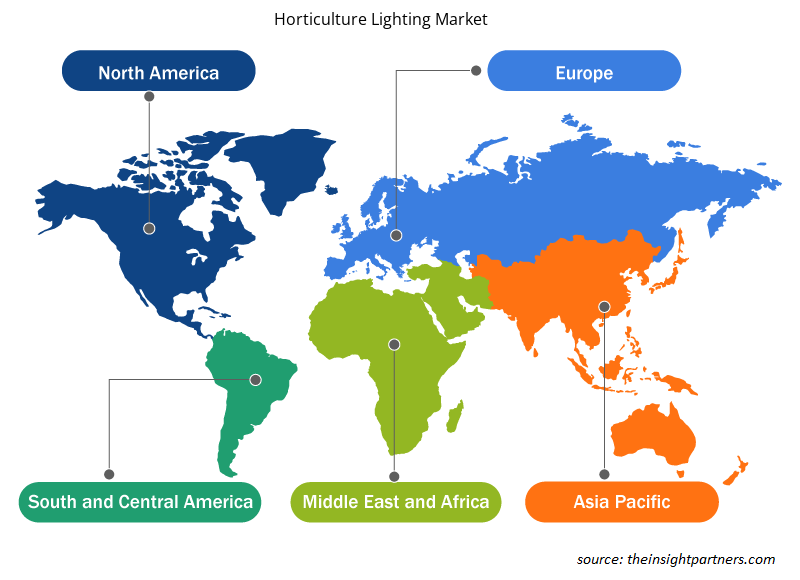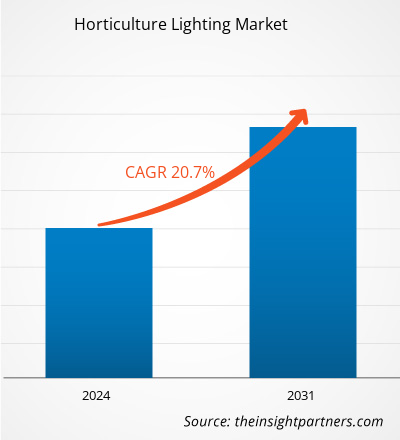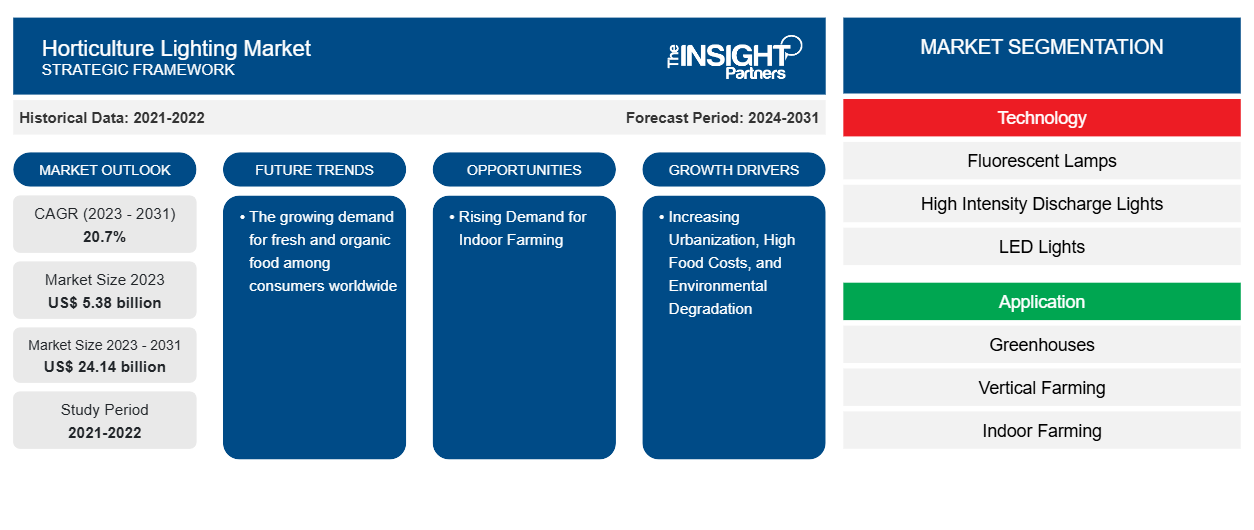Der Markt für Gartenbeleuchtung soll von 5,38 Milliarden US-Dollar im Jahr 2023 auf 24,14 Milliarden US-Dollar im Jahr 2031 anwachsen. Der Markt soll zwischen 2023 und 2031 eine durchschnittliche jährliche Wachstumsrate (CAGR) von 20,7 % verzeichnen. Die weltweit steigende Nachfrage der Verbraucher nach frischen und biologischen Lebensmitteln dürfte ein wichtiger Trend auf dem Markt für Gartenbeleuchtung bleiben.
Marktanalyse für Gartenbaubeleuchtung
Der Markt für Gartenbeleuchtung wächst aufgrund der zunehmenden Urbanisierung, der hohen Lebensmittelkosten, der Umweltzerstörung, der steigenden Investitionen in moderne Gartenbautechniken und der Nachfrage nach maßgeschneiderten Beleuchtungslösungen rasant. Der Markt wächst stetig, angetrieben von der wachsenden Nachfrage nach energieeffizienten landwirtschaftlichen Geräten und staatlichen Initiativen zur Unterstützung des Indoor -Anbaus . Darüber hinaus bieten die steigende Nachfrage nach Indoor-Anbau und die wachsende Heimwerker- und Heimgartenbranche lukrative Möglichkeiten für Marktwachstum.
Marktübersicht für Gartenbaubeleuchtung
Bei der Gartenbeleuchtung werden künstliche Lichtquellen verwendet, um das Pflanzenwachstum unter kontrollierten Bedingungen wie Gewächshäusern, Indoor-Farmen und Wachstumskammern zu fördern. Diese Lampen spielen eine entscheidende Rolle bei der Bereitstellung des Lichtspektrums, der Lichtdauer und der Lichtintensität, um natürliches Sonnenlicht zu simulieren oder zu verstärken und so die Photosynthese und die allgemeine Entwicklung der Pflanzen zu verbessern.
Die Beleuchtung im Gartenbau ist eine wichtige Technik, um die landwirtschaftlichen Erträge zu steigern, die Wachstumsperioden zu verlängern und eine gleichbleibende Pflanzenqualität zu erhalten. Unternehmen können optimale Bedingungen für verschiedene Kulturpflanzen schaffen, indem sie innovative Beleuchtungstechnologien wie LED-Systeme nutzen , die eine präzise Steuerung der Lichteinstellungen ermöglichen, unabhängig von Wetterbedingungen oder geografischen Einschränkungen. Darüber hinaus ermöglicht die datengesteuerte Natur aktueller Beleuchtungssysteme im Gartenbau den Unternehmen, die Lichtbedingungen in Echtzeit zu überwachen und zu ändern, was zu besser informierten Entscheidungen und einer besseren Ressourcenzuweisung führt.
Passen Sie diesen Bericht Ihren Anforderungen an
Sie erhalten kostenlose Anpassungen an jedem Bericht, einschließlich Teilen dieses Berichts oder einer Analyse auf Länderebene, eines Excel-Datenpakets sowie tolle Angebote und Rabatte für Start-ups und Universitäten.
-
Holen Sie sich die wichtigsten Markttrends aus diesem Bericht.Dieses KOSTENLOSE Beispiel umfasst eine Datenanalyse von Markttrends bis hin zu Schätzungen und Prognosen.
Treiber und Chancen auf dem Gartenbaubeleuchtungsmarkt
Zunehmende Urbanisierung, hohe Lebensmittelpreise und Umweltzerstörung treiben den Markt an
Die zunehmende Urbanisierung erhöht die Gartenbauproduktion, um den Bedarf an Nahrungsmitteln zu decken, was wahrscheinlich das Marktwachstum vorantreiben wird. Darüber hinaus treiben der Mangel an Bewässerungswasser für Farmen und die steigenden Lebensmittelpreise, die die Landwirte zum Gartenbau verlagern, den Markt an. Laut dem US-Landwirtschaftsministerium stieg der Verbraucherpreisindex (CPI) im Juli 2022 um 8,5 %. Dieser CPI und die Lebensmittelpreise stiegen zwischen Juni 2022 und Juli 2022 um 1,1 %, während die Lebensmittelpreise im Juli 2021 um 10,9 % stiegen. Die steigende Verbrauchernachfrage nach natürlichen und nahrhaften Mahlzeiten lässt das Angebot an städtischen Gartenbauprodukten ansteigen. Die zunehmende Verwendung und Entwicklung umweltfreundlicher und energieeffizienter LEDs im Gartenbau zur Steigerung des Ernteertrags durch Reduzierung des Energieverbrauchs treibt den Markt im Prognosezeitraum an. Die DesignLights Consortium Organization schätzt, dass durch die Optimierung der Gartenbeleuchtung jährlich bis zu 240 Millionen USD an Strom eingespart werden könnten. Dies ermutigt die Marktteilnehmer, energieeffiziente Beleuchtung für den Gartenbau zu entwickeln, um den steigenden Bedarf an Lebensmitteln zu decken und so den Markt anzukurbeln.
Steigende Nachfrage nach Indoor-Farming – eine Chance auf dem Markt für Gartenbeleuchtung
Die steigende Nachfrage nach der Zubereitung gesunder und nahrhafter Lebensmittel zu Hause ermutigt Verbraucher, Indoor-Farming-Techniken anzuwenden, was Chancen auf dem Markt schafft. Indoor-Farming wird in Großstädten als Reaktion auf die Nahrungsmittelknappheit immer beliebter. Verbraucher auf der ganzen Welt legen Wert auf das Wachstum des Gartenbausektors, um den Anforderungen der Nahrungsmittelknappheit gerecht zu werden und den weltweiten Export von Gartenbauprodukten zu fördern. Steigende Gartenbauexporte ließen die Nachfrage nach Agrartechnologie ansteigen, die den Indoor-Farming-Betrieb erleichterte. Die Einführung neuartiger Agrartechnologie, wie z. B. LED-Beleuchtung für kontrolliertes Klima im Indoor-Farming, schafft im Prognosezeitraum erhebliche Wachstumschancen für das Marktwachstum.
Segmentierungsanalyse des Marktberichts für Gartenbaubeleuchtung
Wichtige Segmente, die zur Ableitung der Marktanalyse für Gartenbeleuchtung beigetragen haben, sind Technologie, Anwendung und Anbau.
- Basierend auf der Technologie ist der Markt für Gartenbeleuchtung in Leuchtstofflampen, Hochdruckentladungslampen und LED-Leuchten unterteilt. Das Segment LED-Leuchten hatte im Jahr 2023 einen größeren Marktanteil.
- Auf der Grundlage der Anwendung ist der Markt in Gewächshäuser, vertikale Landwirtschaft und Indoor-Landwirtschaft segmentiert. Das Gewächshaussegment hatte im Jahr 2023 einen größeren Marktanteil.
- In Bezug auf den Anbau wird der Markt in Obst und Gemüse sowie Blumenzucht unterteilt. Das Segment Obst und Gemüse hatte im Jahr 2023 einen größeren Marktanteil.
Marktanteilsanalyse für Gartenbaubeleuchtung nach Geografie
Der geografische Umfang des Marktberichts zur Gartenbeleuchtung ist hauptsächlich in fünf Regionen unterteilt: Nordamerika, Asien-Pazifik, Europa, Naher Osten und Afrika sowie Südamerika/Süd- und Mittelamerika.
In Bezug auf den Umsatz hatte Europa den größten Marktanteil im Bereich Gartenbeleuchtung, was auf die Präsenz großer Beleuchtungshersteller wie Osram Licht AG, Valoya, Gavita und anderer zurückzuführen ist. Diese Akteure konzentrieren sich auf die Entwicklung energieeffizienter und nachhaltiger Beleuchtung für den Gartenbau, was den Markt voraussichtlich ankurbeln wird. Darüber hinaus verfügen Länder wie Spanien, die Niederlande, Frankreich und Italien über ausgedehnte Gewächshausanbauflächen. Diese Länder setzen LED-Leuchten ein, um das Wachstum von Pflanzen für den Indoor-Anbau zu fördern. Der zunehmende Anbau von Getreide, Obst und Gemüse zur Deckung des wachsenden Nahrungsmittelbedarfs in europäischen Ländern erhöht die Nachfrage nach Gartenbeleuchtung für den Indoor-Anbau und treibt den Markt an.
Regionale Einblicke in den Markt für Gartenbeleuchtung
Die regionalen Trends und Faktoren, die den Markt für Gartenbeleuchtung im Prognosezeitraum beeinflussen, wurden von den Analysten von Insight Partners ausführlich erläutert. In diesem Abschnitt werden auch die Marktsegmente und die Geografie für Gartenbeleuchtung in Nordamerika, Europa, im asiatisch-pazifischen Raum, im Nahen Osten und Afrika sowie in Süd- und Mittelamerika erörtert.

- Erhalten Sie regionale Daten zum Markt für Gartenbeleuchtung
Umfang des Marktberichts für Gartenbaubeleuchtung
| Berichtsattribut | Details |
|---|---|
| Marktgröße im Jahr 2023 | 5,38 Milliarden US-Dollar |
| Marktgröße bis 2031 | 24,14 Milliarden US-Dollar |
| Globale CAGR (2023 - 2031) | 20,7 % |
| Historische Daten | 2021-2022 |
| Prognosezeitraum | 2024–2031 |
| Abgedeckte Segmente |
Nach Technologie
|
| Abgedeckte Regionen und Länder |
Nordamerika
|
| Marktführer und wichtige Unternehmensprofile |
|
Marktteilnehmerdichte: Der Einfluss auf die Geschäftsdynamik
Der Markt für Gartenbeleuchtung wächst rasant, angetrieben durch die steigende Nachfrage der Endnutzer aufgrund von Faktoren wie sich entwickelnden Verbraucherpräferenzen, technologischen Fortschritten und einem größeren Bewusstsein für die Vorteile des Produkts. Mit steigender Nachfrage erweitern Unternehmen ihr Angebot, entwickeln Innovationen, um die Bedürfnisse der Verbraucher zu erfüllen, und nutzen neue Trends, was das Marktwachstum weiter ankurbelt.
Die Marktteilnehmerdichte bezieht sich auf die Verteilung von Firmen oder Unternehmen, die in einem bestimmten Markt oder einer bestimmten Branche tätig sind. Sie gibt an, wie viele Wettbewerber (Marktteilnehmer) in einem bestimmten Marktraum im Verhältnis zu seiner Größe oder seinem gesamten Marktwert präsent sind.
Die wichtigsten auf dem Markt für Gartenbeleuchtung tätigen Unternehmen sind:
- Agrolux
- Bridgelux, Inc.
- Allgemeine Elektricitätsgesellschaft
- Heliospectra AB
- Hortilux Schrader BV
- Hubbell, Inc.
Haftungsausschluss : Die oben aufgeführten Unternehmen sind nicht in einer bestimmten Reihenfolge aufgeführt.

- Überblick über die wichtigsten Akteure auf dem Markt für Gartenbeleuchtung
Neuigkeiten und aktuelle Entwicklungen zum Markt für Gartenbeleuchtung
Der Markt für Gartenbeleuchtung wird durch die Erhebung qualitativer und quantitativer Daten nach Primär- und Sekundärforschung bewertet, die wichtige Unternehmensveröffentlichungen, Verbandsdaten und Datenbanken umfasst. Im Folgenden finden Sie eine Liste der Entwicklungen auf dem Markt für Gartenbeleuchtung und Strategien:
- Im Juni 2023 stellte ams-OSRAM AG die fünfte Generation seiner beliebten OSLON Square Hyper Red Gartenbau-LED vor, die für schnelleres Pflanzenwachstum und optimierte Systemkosten entwickelt wurde. Das Unternehmen liefert weiterhin wichtige Innovationen auf der Grundlage von Kundenfeedback, indem es LED-Lösungen entwickelt, die einen hohen photosynthetischen Photonenfluss (PPF) mit höherer Effizienz erzeugen als die vorherige Generation von Hyper Red 660 nm LEDs. Die neue OSLON Square Hyper Red LED ist für den Einsatz in allen Gartenbau-Beleuchtungsanwendungen vorgesehen, einschließlich Gewächshaus-Ober- und Zwischenbeleuchtung, Einzelquellenbeleuchtung und vertikalen Landwirtschaftsanwendungen. (Quelle: ams-OSRAM AG, Pressemitteilung, 2023)
Marktbericht zur Gartenbaubeleuchtung – Abdeckung und Ergebnisse
Der Bericht „Marktgröße und Prognose für Gartenbaubeleuchtung (2021–2031)“ bietet eine detaillierte Analyse des Marktes, die die folgenden Bereiche abdeckt:
- Marktgröße und Prognose auf globaler, regionaler und Länderebene für alle wichtigen Marktsegmente, die im Rahmen des Projekts abgedeckt sind
- Marktdynamik wie Treiber, Beschränkungen und wichtige Chancen
- Wichtige Zukunftstrends
- Detaillierte PEST/Porters Five Forces- und SWOT-Analyse
- Globale und regionale Marktanalyse mit wichtigen Markttrends, wichtigen Akteuren, Vorschriften und aktuellen Marktentwicklungen
- Branchenlandschaft und Wettbewerbsanalyse, einschließlich Marktkonzentration, Heatmap-Analyse, prominenten Akteuren und aktuellen Entwicklungen
- Detaillierte Firmenprofile
- Historische Analyse (2 Jahre), Basisjahr, Prognose (7 Jahre) mit CAGR
- PEST- und SWOT-Analyse
- Marktgröße Wert/Volumen – Global, Regional, Land
- Branchen- und Wettbewerbslandschaft
- Excel-Datensatz
Aktuelle Berichte
Erfahrungsberichte
Grund zum Kauf
- Fundierte Entscheidungsfindung
- Marktdynamik verstehen
- Wettbewerbsanalyse
- Kundeneinblicke
- Marktprognosen
- Risikominimierung
- Strategische Planung
- Investitionsbegründung
- Identifizierung neuer Märkte
- Verbesserung von Marketingstrategien
- Steigerung der Betriebseffizienz
- Anpassung an regulatorische Trends























 Kostenlose Probe anfordern für - Markt für Gartenbeleuchtung
Kostenlose Probe anfordern für - Markt für Gartenbeleuchtung